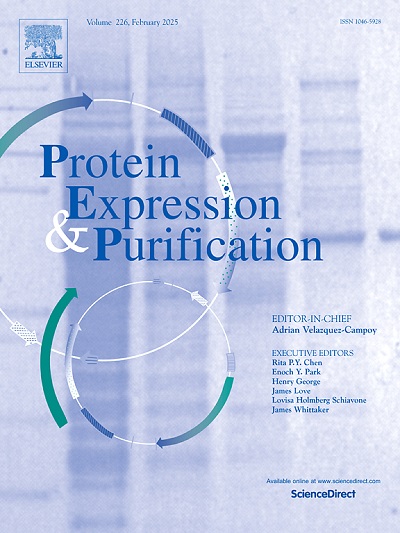Biochemical characterization of histidinol dehydrogenase from the human pathogen Neisseria gonorrhoeae
IF 1.2
4区 生物学
Q4 BIOCHEMICAL RESEARCH METHODS
引用次数: 0
Abstract
Histidinol dehydrogenase (HisD, E.C. 1.1.1.23), encoded by the hisD gene and catalyzing the final two steps in the l-histidine biosynthesis, has emerged as a promising antibacterial target for several human pathogens, such as Brucella suis and Mycobacterium tuberculosis. Herein, biochemical properties on recombinant HisD from the human pathogen Neisseria gonorrhoeae (NgHisD) were characterized in detail. SDS-PAGE and size-exclusion chromatography revealed that recombinant NgHisD is a homodimer (∼105 kDa native size; ∼47 kDa subunit). Kinetic analysis identified this protein as a highly selective NAD+-dependent enzyme (specific activity: 17.3 ± 0.4 U mg−1), exhibiting minimal activity with NADP+. The KM values for NAD+ and l-histidinol were 0.9 ± 0.3 mM and 45 ± 6 μM, respectively. Maximal activity occurred at pH 9.5 and 45 °C in the presence of Mn2+. Heat-inactivation experiment showed that rapid inactivation began to occur following incubation at 45 °C for 30 min. The metal ions coordinated by the enzyme were not sequestered by 10 mM EDTA but were efficiently chelated by 1,10-phenanthroline. The recombinant NgHisD lost 85 % activity in the presence of 1 mM 1,10-phenantroline. Our study not only establishes a foundation for investigating the physiological function of NgHisD in vivo but also uncovers the absence of the canonical histidine biosynthesis pathway in Neisseria cinerea.
淋病奈瑟菌组氨酸二醇脱氢酶的生化特性研究。
组氨酸脱氢酶(HisD, E.C. 1.1.1.23)由HisD基因编码,催化l-组氨酸生物合成的最后两步,已成为猪布鲁氏菌和结核分枝杆菌等几种人类病原体的有前途的抗菌靶点。本文对人淋病奈瑟菌(Neisseria gonorrhoeae, NgHisD)重组HisD的生化特性进行了详细的表征。SDS-PAGE和大小隔离层析显示重组NgHisD是一个同源二聚体(约105 kDa天然大小;约47 kDa亚基)。动力学分析表明,该蛋白是一种高度选择性的NAD+依赖酶(比活性:17.3±0.4 U mg-1),对NADP+的活性极小。NAD+和l-组氨酸二醇的KM值分别为0.9±0.3 mM和45±6 μM。在pH 9.5和45°C条件下,Mn2+的存在使活性达到最大。热失活实验表明,在45℃孵育30 min后,开始出现快速失活。该酶配位的金属离子不被10 mM EDTA隔离,而被1,10-菲罗啉有效地螯合。重组NgHisD在1mm - 1,10-phenantroline存在下失去85%的活性。我们的研究不仅为研究NgHisD在体内的生理功能奠定了基础,而且揭示了灰奈瑟菌中缺乏典型的组氨酸生物合成途径。
本文章由计算机程序翻译,如有差异,请以英文原文为准。
求助全文
约1分钟内获得全文
求助全文
来源期刊

Protein expression and purification
生物-生化研究方法
CiteScore
3.70
自引率
6.20%
发文量
120
审稿时长
32 days
期刊介绍:
Protein Expression and Purification is an international journal providing a forum for the dissemination of new information on protein expression, extraction, purification, characterization, and/or applications using conventional biochemical and/or modern molecular biological approaches and methods, which are of broad interest to the field. The journal does not typically publish repetitive examples of protein expression and purification involving standard, well-established, methods. However, exceptions might include studies on important and/or difficult to express and/or purify proteins and/or studies that include extensive protein characterization, which provide new, previously unpublished information.
 求助内容:
求助内容: 应助结果提醒方式:
应助结果提醒方式:


